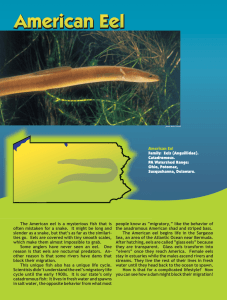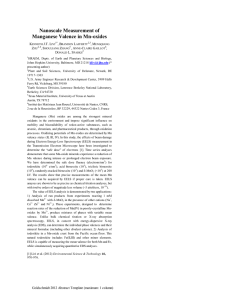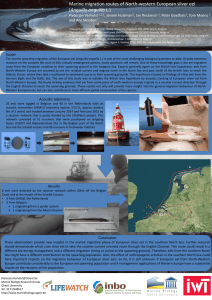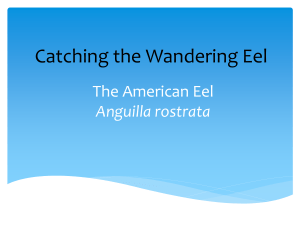EELS (ANGUILLA ANGUILLA (L.)) OF THE LOWER RIVER SHANNON, WITH
advertisement
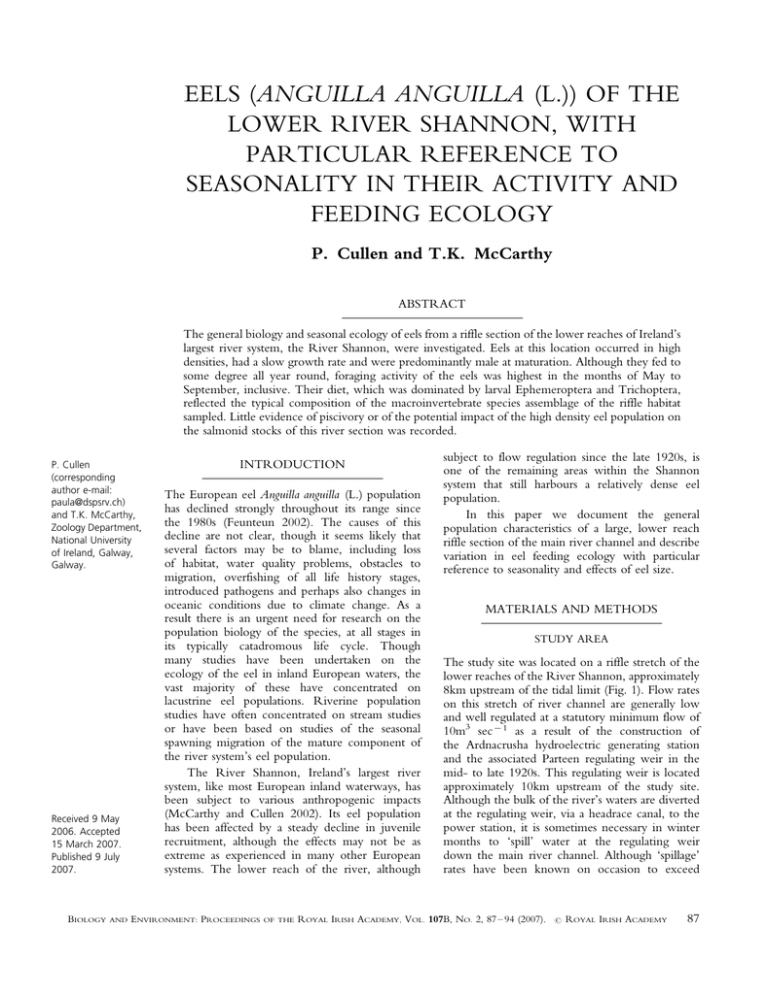
EELS (ANGUILLA ANGUILLA (L.)) OF THE LOWER RIVER SHANNON, WITH PARTICULAR REFERENCE TO SEASONALITY IN THEIR ACTIVITY AND FEEDING ECOLOGY P. Cullen and T.K. McCarthy ABSTRACT The general biology and seasonal ecology of eels from a riffle section of the lower reaches of Ireland’s largest river system, the River Shannon, were investigated. Eels at this location occurred in high densities, had a slow growth rate and were predominantly male at maturation. Although they fed to some degree all year round, foraging activity of the eels was highest in the months of May to September, inclusive. Their diet, which was dominated by larval Ephemeroptera and Trichoptera, reflected the typical composition of the macroinvertebrate species assemblage of the riffle habitat sampled. Little evidence of piscivory or of the potential impact of the high density eel population on the salmonid stocks of this river section was recorded. P. Cullen (corresponding author e-mail: paula@dspsrv.ch) and T.K. McCarthy, Zoology Department, National University of Ireland, Galway, Galway. Received 9 May 2006. Accepted 15 March 2007. Published 9 July 2007. BIOLOGY AND INTRODUCTION The European eel Anguilla anguilla (L.) population has declined strongly throughout its range since the 1980s (Feunteun 2002). The causes of this decline are not clear, though it seems likely that several factors may be to blame, including loss of habitat, water quality problems, obstacles to migration, overfishing of all life history stages, introduced pathogens and perhaps also changes in oceanic conditions due to climate change. As a result there is an urgent need for research on the population biology of the species, at all stages in its typically catadromous life cycle. Though many studies have been undertaken on the ecology of the eel in inland European waters, the vast majority of these have concentrated on lacustrine eel populations. Riverine population studies have often concentrated on stream studies or have been based on studies of the seasonal spawning migration of the mature component of the river system’s eel population. The River Shannon, Ireland’s largest river system, like most European inland waterways, has been subject to various anthropogenic impacts (McCarthy and Cullen 2002). Its eel population has been affected by a steady decline in juvenile recruitment, although the effects may not be as extreme as experienced in many other European systems. The lower reach of the river, although ENVIRONMENT: PROCEEDINGS OF THE subject to flow regulation since the late 1920s, is one of the remaining areas within the Shannon system that still harbours a relatively dense eel population. In this paper we document the general population characteristics of a large, lower reach riffle section of the main river channel and describe variation in eel feeding ecology with particular reference to seasonality and effects of eel size. MATERIALS AND METHODS STUDY AREA The study site was located on a riffle stretch of the lower reaches of the River Shannon, approximately 8km upstream of the tidal limit (Fig. 1). Flow rates on this stretch of river channel are generally low and well regulated at a statutory minimum flow of 10m3 sec1 as a result of the construction of the Ardnacrusha hydroelectric generating station and the associated Parteen regulating weir in the mid- to late 1920s. This regulating weir is located approximately 10km upstream of the study site. Although the bulk of the river’s waters are diverted at the regulating weir, via a headrace canal, to the power station, it is sometimes necessary in winter months to ‘spill’ water at the regulating weir down the main river channel. Although ‘spillage’ rates have been known on occasion to exceed ROYAL IRISH ACADEMY, VOL. 107B, NO. 2, 87 94 (2007). # ROYAL IRISH ACADEMY 87 BIOLOGY Fig. 1 * AND a) maps of the River Shannon, (b) the lower River Shannon and (c) and the study site. 600m3 sec1, this is the exception rather than the norm, and during the period of this study water was ‘spilt’ over a three week period in late February and early March at an average rate of 150.29SD 13.4m3 sec1. Although some sections of the lower River Shannon are important for coarse fishing, much of this stretch of river channel has been successfully developed, and is internationally renowned, for salmon angling. The diversion of water from the main river channel in 1929 had a profound impact on the physical nature and ecology of the river. Many areas of the river channel became dry, resulting in a significant and immediate loss of salmonid spawning habitat (Went 1970). Natural encroachment of bankside vegetation also occurred, and islands emerged in many areas and 88 ENVIRONMENT now permanently braid the channel. There is a long history of construction of instream features on salmon rivers in Europe, and prior to the impact of the hydroelectric works numerous pools had been developed on the lower River Shannon. These pools have been maintained, and many instream structures have been constructed to cater for the reduced flows. This work has generally been carried out on an ad hoc basis since the 1930s. The survey site was typical of riffle sections of this lower section of the River Shannon. The channel was broken by a series of small islands, and the site was bounded to the north and the south by a series of small, artificially created falls (Fig. 1). The water depth ranged between 15cm and 60cm, with a substrate comprised mainly of pebbles and slightly larger rocks. EELS (ANGUILLA ANGUILLA (L.)) OF THE LOWER RIVER SHANNON METHODS RESULTS The site was electrofished on ten occasions between April 1996 and April 1997. On each sampling occasion a series of twenty-minute fishings were carried out, with eel as the only target species. Details of the number of fishings, water temperatures, conductivity and the total area fished were recorded. Although only single fishings were carried out, electrofishing is known to be an effective method of capturing eels at this location, and so relative densities (no. eels m 2 fished) of eels were calculated as an index of density. On capture the eels were anaesthetised, weighed to the nearest gram, individually bagged and numbered and transported back to the laboratory on ice to help preserve stomach contents. Eels were then frozen and stored at 158C for several months prior to further analysis. Following thawing the length of each eel was measured. Subsamples of eels representative of each sampling date were selected for dietary analysis. Stomachs were dissected out, percentage stomach fullness estimated by eye, and food items then identified to group level. Saggital otoliths were removed from all eels and allowed to dry for at least a week before further processing. The otoliths were aged using two different methods. The first involved the burning and cracking of otoliths and was used on larger otoliths. Smaller otoliths were aged after they had been cleared in creosote. These methods had already been proven to be suitable for use on the lower River Shannon eels (Cullen and McCarthy 2003). A total of 1467 eels were captured over the study period, and an overview of the results for each of the ten occasions on which sampling took place is presented in Table 1. There was an apparent seasonality to the capture rate of the eels, with lower rates recorded during the winter months. This was confirmed by means of a partial correlation of capture rate with temperature, controlling for conductivity (correlation coefficient: 0.696, p 0.037, n 13). The sizes of eels captured ranged from 76mm to 742mm, with an overall mean size of 200.5mm. However, the largest individual captured was of exceptional size in relation to the bulk of eels captured, with approximately 99% of the overall sample of eels captured less than 400mm length (Fig. 2). The weights of eels captured ranged from less than 1g to a maximum of 754g in the case of the largest eel captured, with 58% of the individuals caught less than 10g weight and 99% of the sample less than 100g. The overall relationship between length and weight was expressed by the regression log wt 3.176 log lt 6.228, R2 0.96. There were no apparent seasonal differences in the condition factors of the eels captured. Eels in the smallest length size category (B100mm), which were generally accepted to be those spending their first year in freshwater, were seen to be present in all months, but were less numerous in winter months. No apparent trend as to their time of immigration upstream to this region from estuarine waters was found. A total of 1372 individuals were successfully aged. Freshwater age was calculated in all cases, i.e. Table 1 * Details of the numbers of eels captured by electrofishing at the lower River Shannon site on ten dates between April 1996 and April 1997, together with information on water temperature, conductivity, areas fished and length of fishing times. Water Conductivity temperature (mS cm 1 ) ( 8C) 04 April 1996 10 May 1996 19 June 1996 25 July 1996 03 Sept 1996 08 Oct 1996 11Nov 1996 19 Dec 1996 27 Jan 1997 17 April 1997 8 11 19 19 16 11 9 6.5 6 11.5 152 164 230 470 460 423 384 404 549 460 Overall No. of eels 180 181 195 118 103 174 93 111 129 183 1467 Time fished Area fished (min) (m2 ) 100 125 100 40 60 100 80 100 80 80 865 350 380 320 160 220 300 280 320 260 260 2850 Relative Capture rate density (no. man-hr1 ) (no. m2 ) 0.51 0.48 0.61 0.74 0.47 0.58 0.33 0.35 0.50 0.70 0.51 54.0 43.4 58.5 88.5 51.5 52.2 34.9 33.3 48.4 68.6 50.9 89 BIOLOGY AND ENVIRONMENT 450 400 15 350 10 Length (mm) % frequency 20 5 0 0 Length (mm) * Fig. 2 Length frequency distribution of the 1467 eels captured on the lower River Shannon during the current study. 0 indicates an elver that has just arrived in freshwater. In the overall sample eel ages ranged from a minimum of 0, to a maximum of 30 in the case of the largest individual sampled, although the absolute age of this individual is somewhat doubtful due to difficulties in reading the outermost part of the otolith. The average age of the eels sampled was 8.2 years. The relationship between length and age was used in the calculation of a von Bertalanffy growth curve (Fig. 3). As was the case with the mean lengths and weights of the eels, there was some variation in the mean age of eel capture in each of the ten samples analysed. Similarly, variation occurred in respect of the mean size of eel in each of the age groups throughout the sampling period. It had been hoped that it would be possible to analyse the seasonal changes in growth rates of the eels sampled. However, due to a number factors* the number of age groups present in each sample, the low number of eels in each of the age groups in each sample and the variable size range of eels at each age* it was felt that this analysis would not be possible. Stomach contents from a subsample of 30 eels from each of the ten sampling dates were analysed. As can be seen in Fig. 4 there is a clear seasonal pattern to the feeding behaviour of the eels in terms of both mean percentage stomach fullness and the number of eel stomachs containing food items. With the exception of the sample from the month of July 96, when eels larger than 300mm were generally absent from the sample analysed, no overall differences in the length frequencies of eels whose stomach contents were examined were noted (Mann Whitney U tests, p 0.05). Similarly no overall differences were found between the length frequencies of the samples of eels whose stomach contents were examined and the monthly sample from which they originated (Mann Whitney U tests, p 0.05). Of the 120 eel stomachs examined from the months of May, June, July and September 1996, 94 contained prey remains, and of these only eleven contained remains that could not be positively identified. 90 y = 747.4(1-e-0.02(t+3.91)) 250 200 150 0 75 70 65 0 0 0 60 55 0 0 0 0 50 45 40 35 0 30 25 0 0 15 20 10 0 0 300 100 50 0 0 5 10 15 20 25 30 35 Age * Fig. 3 Length at age relationship and the associated von Bertalanffy growth curve, for the 1372 lower River Shannon eels that were aged. In total 1215 individual prey items were identified from the diet analysis of these eels, and Table 2 presents a summary of the results of these analyses, both on a monthly basis and overall. Overall, the diet of the eel appeared to be dominated by five main groups: trichopteran larvae, ephemeropteran nymphs, gastropods, dipteran larvae and isopods. A summary of the overall relationship between eel size and the type of prey consumed is presented in Table 3. The average number of prey items per eel increased with eel size category. Salmonid remains were recorded on three occasions, in the stomachs of eels in the largest size category. DISCUSSION The relative densities of eels at the lower River Shannon site during the current study were similar to values recorded during previous electrofishing surveys of the same region (McCarthy et al. 1999). These high relative densities are typical of the lower reaches of a river system and were shown to be significantly higher than those recorded further upstream in the Shannon system (Cullen 1999). Similar results have been recorded for many other European river systems (Aprahamian 1986; Feunteun et al. 1998). Another feature that is typical of high density, lower river eel populations is small eel size, and results similar to those recorded in the current study have also been recorded by many authors (Legault 1986; Naismith and Knights 1993; Lobon-Cervia et al. 1995; Feunteun et al. 1998). Indeed, previous studies of eels on the Shannon system have indicated that the lower River Shannon region produces predominantly male eels, which mature at a maximum of approximately 430mm (McCarthy et al. 1999; McCarthy and Cullen 2000a). The results of the ageing studies in the present investigation indicated that the eels had a relatively slow growth rate. This is not atypical of a population that is dominated by male eels, and ANGUILLA (L.)) OF THE LOWER RIVER SHANNON 30 60 25 50 20 40 15 30 10 20 5 10 0 % stomach fullness No. eel stomachs containing food items EELS (ANGUILLA 0 Apr- May- Jun96 96 96 Jul96 Aug- Sep- Oct- Nov- Dec- Jan- Feb- Mar- Apr96 96 96 96 96 97 97 97 97 Sampling date Ide nti fi abl e pr ey Unidentifiable prey % stomach fullness * Fig. 4 Results of the analysis of the stomach contents of eels captured on the lower River Shannon over an annual cycle. The number of eels containing food items, either identifiable or unidentifiable, is presented along with the mean percentage stomach fullness for each sampling date. On each occasion the stomach contents of 30 eels were analysed. these results agree with those of other studies of eels of temperate waters (Naismith and Knights 1993; McCarthy et al. 1999). The current study involved the comprehensive sampling, where possible, of all year classes present in the population. This is important in the study of growth rate of eels due to a number of reasons (Sinha and Jones 1967b; Tesch 1998). Irregularities occur in length at age data, with wide ranges on the sizes of eels in each age class and considerable overlap between age classes. The wide variation in eel growth throughout the species range is also Table 2 * the reason why growth models such as the von Bertalanffy growth curve, which is frequently used for other fish species, sometimes do not fit, as eels do not necessarily follow the conventional growth patterns of other fish species. As eels are temperature dependent, populations in Northern European locations tend to become noticeably less active as water temperatures drop in the winter months, and they remain inconspicuous and relatively inactive until temperatures again rise in the spring (Tesch 1999). Water temperature is known to affect the efficiency of capture of fish by Summary of the dietary composition of the lower River Shannon electrofished eels examined during the months of May, June, July and September 1996. Data is presented both in terms of numbers of prey individuals identified (No.) and their frequencies of occurrence, i.e. no. of eels in which they occurred (Freq.). May No. Hirudinea Cladocera Isopoda Amphipoda Gastropoda Ephemeroptera Trichoptera Odonata Hemiptera Diptera Coleoptera Fish 1 15 3 5 55 29 4 3 3 June July September Freq. No. Freq. No. Freq. No. Freq. 1 3 3 4 14 7 3 2 3 1 69 2 37 99 231 3 9 1 1 8 2 8 20 15 2 5 1 1 4 52 53 19 7 1 1 2 8 14 8 6 1 6 1 26 25 371 76 3 4 1 5 12 6 7 3 91 BIOLOGY AND electrofishing. Because many fish are less active at colder temperatures they can remain hidden in burrows, crevices, etc., and thus are more difficult to catch by electrofishing (Zalewski and Cowx 1990). If the rate of capture recorded during the current study is taken as an index of eel activity, then by correlating water temperature against rate of capture while controlling for water conductivity, which is also known to affect the efficiency of electrofishing (Zalewski and Cowx 1990), it was possible to demonstrate this temperature influenced nature of the lower River Shannon eels’ activity. Seasonality in the feeding behaviour of eels has also been documented elsewhere (Thomas 1962; Sinha and Jones 1975), and eels in temperate regions generally tend to cease feeding or feed to a lesser extent during the winter months (Tesch 1999). There was a definite seasonal pattern in the feeding behaviour of the lower River Shannon eels, and while some feeding did occur during the colder months of the year, the main feeding season ran from May to September. Similarly there was some evidence of seasonal differences in the composition of the diet. While some food items were only seen in the diet of these eels in the earlier months (e.g. fish), others (such as dipteran larvae) increased in importance later in the season. Eels are known for the diverse range of prey items that they ingest, making use of much of the aquatic fauna in the regions they inhabit, and it has also been noted that the composition of the diet can change seasonally, reflecting changes in the aquatic community (Tesch 1999). Coupled with the fact that eels are also known to stay within limited home ranges, especially during the feeding season (McGovern and McCarthy 1992; Tesch 1999), it is therefore Table 3 * likely that the diet of the lower River Shannon eels reflects composition of the available macroinvertebrate community at the study site and in the area surrounding the site. In general, the macroinvertebrates recorded from the food of the eels are not unusual for a riffle area. Indeed, in a review of the macroinvertebrate communities of the River Shannon, Bowman (1998) found that in the faster flowing reaches of the lower River Shannon the macroinvertebrate community is dominated by ephemeropterans and trichopterans. In general, larger prey, such as fish, were absent from the diets of most of the lower River Shannon eels. As with many other fish species, the size of prey generally increases with that of the eel (Cairns 1941; Costa et al . 1992). Although during this study no overall trend was observed in respect of increases in prey size with eel size, it was clear that some of the larger prey items were only found in larger eels. Leech remains were only found in eels of length greater than 200mm, and larger prey items such as Odonata and fish were only found in eels greater than 300mm. The impact of eels on other fish stocks, in particular salmonids, has long been the concern of salmon fishery managers. Although preliminary analysis by Mann and Blackburn (1991) suggested strong overlap in the diets of salmonids and eels, further analysis indicated distinct differences in the feeding behaviours of both groups that would minimise competitive impacts. They also concluded that as the eel population in the stream they surveyed consisted primarily of individuals less than 400mm length, piscivory on salmonids was not likely to be a problem. In a survey of a number of studies carried out in England (Frost 1946; Jones A summary of the numerical composition of the diets of the lower River Shannon eels in each of four size categories. 0 100mm No. eels No. eels with prey Hirudinea Cladocera Isopoda Amphipoda Gastropoda Ephemeroptera Trichoptera Odonata Hemiptera Diptera Coleoptera Fish Total 92 ENVIRONMENT 13 3 3 3 100 200mm 45 32 4 3 80 13 43 4 147 200 300mm 34 24 2 72 4 64 98 69 6 1 316 300mm 28 24 1 18 2 53 51 568 4 3 46 3 749 EELS (ANGUILLA ANGUILLA (L.)) and Evans 1960; Thomas 1962; Sinha and Jones 1967a) by Michel and Oberdorff (1995) the authors found that salmonophagic eels represented only 1% of the overall numbers examined. Bearing these facts in mind, and given that the lower River Shannon eel population is generally dominated by smaller male eels (McCarthy et al. 1999; McCarthy and Cullen 2000a), it is likely that piscivory among lower River Shannon eels is minimal. The fact that this area of the Shannon has historically been important as a commercial silver eel fishery yet remains an internationally renowned salmon fishery suggests that it is unlikely that the local eel population has had or will have a deleterious impact on the salmonids of the area. The widespread collapse of European eel Anguilla anguilla (L.) stocks is a matter of great concern (Moriarty and Dekker 1997; ICES 2005), and there is now increasing need for greater knowledge of the population biology and general ecology of all populations of European eel throughout its range (W. Dekker, pers. comm.), in particular if conservation strategies are to be successfully implemented. As this study has indicated, there is considerable knowledge available on lake populations of eels, and to a lesser degree on stream populations, in particular the mature downstream migrating proportion of stream populations. There are, however, few studies on the resident populations of some of Europe’s large rivers. This study has highlighted the presence of a dense population of eels in the lower reaches of one such large river, the River Shannon. This population is of importance not only for the numbers of mature migrating silver eels it can potentially contribute to the spawning stock but also because it has been recognised as a good source of fingerlings and bootlace eels suitable for restocking the lakes of the Shannon system (McCarthy et al. 1999; McCarthy and Cullen 2000b). The approach taken in this study, of analysing many aspects of the eels’ biology and ecology over an annual cycle, and other long-term approaches to the study of eels should be encouraged. As was shown there was considerable variation in many of the factors information recorded in each of the individual samples (sizes and ages of eel, dietary composition, rate of capture). However when taken as a whole the information gathered from all samples gives a clearer picture of the biology and ecology of the population studied. The longevity of European eels and the seasonality of their behaviour, in particular in populations inhabiting the cooler waters of northern Europe, means that in order to truly understand the biology of the species and maximise the outcome of conservation strategies, long-term and integrated studies are necessary. OF THE LOWER RIVER SHANNON ACKNOWLEDGEMENTS The assistance of the Zoology Department Staff, in particular Mr Eoin MacLoughlin and Mr Terry Callanan, is greatly acknowledged. This study was undertaken as part of the Electricity Supply Board River Shannon Eel Management Programme. We are most grateful to ESB Fisheries Conservation for their support and funding of this work. REFERENCES Aprahamian, M.W. 1986 Eel (Anguilla anguilla L.) production in the River Severn, England. Polish Archives of Hydrobiology 33, 373 89. Bowman, J.J. 1998 The Shannon. In C. Moriarty (ed.), Studies of Irish rivers and lakes , 169 89. Dublin. Marine Institute. Cairns, D. 1941 Life history of the two species of New Zealand fresh-water eel. I. Taxonomy, age and growth, migration and distribution. New Zealand Journal of Science and Technology, Section B 23, 53 72. Costa, J.L., Assis, C.A., Almeida, P.A., Moreira, F.M. and Costa, M.J. 1992 On the food of the European eel, Anguilla anguilla (L.), in the upper zone of the Tagus Estuary, Portugal. Journal of Fish Biology 41, 841 50. Cullen, P. 1999 The biology and ecology of eels, Anguilla anguilla L., in the River Shannon. Unpublished PhD thesis, National University of Ireland, Galway. Cullen, P. and McCarthy, T.K. 2003 A comparison of two age determination techniques commonly used for eels (Anguilla anguilla (L. )). Irish Naturalists Journal 27 (8), 301 305. Feunteun, E. 2002 Management and restoration of European eel population (Anguilla anguilla ): an impossible bargain. Ecological Engineering 18, 575 91. Feunteun, E., Acou, A., Guillouet, J., Lafaille, P. and Lagault, A. 1998 Spatial distribution of an eel population Anguilla anguilla L. in a small coastal catchment of northern Brittany (France). Consequences of hydraulic works. Bulletin Francais de la Peche et de la Pisciculture 349, 129-140. Frost, W.E. 1946 Observations on the food of eels (Anguilla anguilla ) from the Windermere catchment area. Journal of Animal Ecology 15, 43 53. Jones, J.W. and Evans, H. 1960 Eels may not be guilty after all. Trout and Salmon 6, 17 18. ICES 2005 Report of the ICES/EIFAC Working Group on Eels. 22 26 November 2004, Galway, Ireland . Copenhagen: ICES CM 2004/ACFM: 90. Legault, A. 1986 Distribution of eel population A. anguilla L. in the watershed of Sevre Niortaise. Vie et Milieu 36, 261 5. Lobon-Cervia, J., Utrilla, C.G. and Rincon, P.A. 1995 Variations in the population dynamics of the European eel Anguilla anguilla (L.) along the course of a Cantabrian river. Ecology of Freshwater Fish 4, 17 27. 93 BIOLOGY AND Mann, R.H.K. and Blackburn, J.H. 1991 The biology of the eel Anguilla anguilla (L.) in an English chalk stream and interractions with juvenile trout Salmo trutta L. and Salmo salar L. Hydrobiologia 218, 65 76. McCarthy, T.K. and Cullen, P. 2000a The River Shannon silver eel fisheries: variations in commercial and experimental catch levels. Dana 12, 59 68. McCarthy, T.K. and Cullen, P. 2000b Eel fishing in the River Shannon: Eel population changes, fishery management options and fishery conservation issues. A synthesis report on the River Shannon Eel Management Programme 1992 2000 . Electricity Supply Board. Dublin McCarthy, T.K. and Cullen, P. 2002 Ireland’s changing freshwater habitats: anthropogenic impacts, fishery management problems and ecohydrological perspectives. Ecohydrology and Hydrobiology 2, 143 8. McCarthy, T.K., Cullen, P. and O’Connor, W. 1999 The biology and management of River Shannon eel populations. Fisheries Bulletin (Dublin ) 17, 9 20. McGovern, P. and McCarthy, T.K. 1992 Local movements of freshwater eels (Anguilla anguilla L.), in western Ireland. In G.I. Priede and S.M. Swift (eds), Wildlife telemetry, remote monitoring and tracking of animals , 319 27. Ellis Hornworth Ltd. England. Michel, P. and Oberdorff, T. 1995 Feeding habits of fourteen European freshwater fish species. Cybium 19, 5 46. Moriarty, C. and Dekker, W. (eds) 1997 Management of European eel . Fisheries Bulletin No.15. Dublin. Roinn na Mara. 94 ENVIRONMENT Naismith, I.A. and Knights, B. 1993 The distribution, density and growth of the European eel, Anguilla anguilla , in the fresh-water catchment of the River Thames. Journal of Fish Biology 42, 217 26. Sinha, V.R.P. and Jones, J.W. 1967a On the food of freshwater eels and their feeding relationships with Salmonidae. Journal of Zoology 153, 119 37, 371 85. Sinha, V.R.P. and Jones, J.W. 1967b On the age and growth of the freshwater eel (Anguilla anguilla ). Journal of Zoology 153, 99 117. Sinha, V.R.P. and Jones, J.W. 1975 The European freshwater eel. Liverpool University Press. Tesch, F.-W. 1998 Anguillidae. In H. Hoestlandt (ed.), The freshwater fishes of Europe. Vol. 2 Clupeidae, Anguillidae . Wiesbaden. AULA-Verlag. Tesch, F.-W. 1999 Der Aal. Berlin. Blackwell Wissenschafts Verlag. Thomas, J.D. 1962 The food and growth of brown trout (Salmo trutta L.) and its feeding relationship with the salmon parr (Salmo salar L.) and the eels (Anguilla anguilla L.) in the River Teify, West Wales. Journal of Animal Ecology 31, 175 205. Went, A.E.J. 1970 Salmon investigations on the River Shannon. In Atlantic Salmon Association Centennial Award Fund . Series of Lectures, 17 22. Quebec. Atlantic Salmon Association. Zalewski, M. and Cowx, I. 1990 Factors affecting the efficiency of electric fishing. In I. Cowx and P. Lamarque (eds), Fishing with electricity: applications in freshwater fisheries management . Oxford. Blackwell Scientific Publishers.

